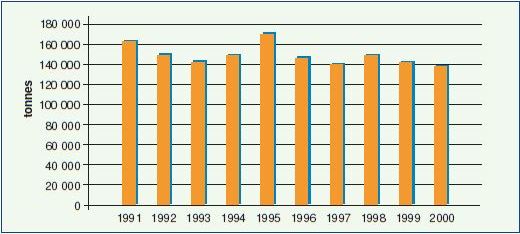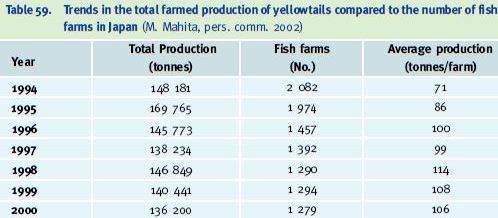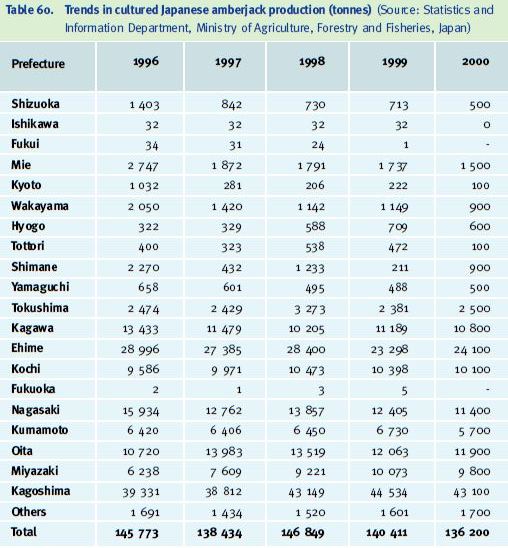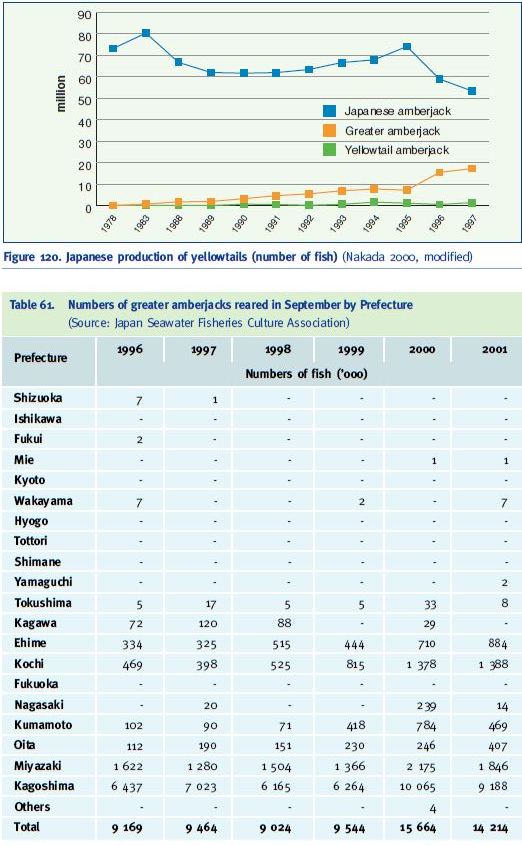Trends in aquaculture production
The global production of yellowtail reported by FAO (FAO 2002a) includes several species but mostly consists of Japanese amberjack (Seriola quinqueradiata). The total farmed production shows a decrease from 162 001 tonnes in 1991 to 137 961 tonnes in 2000 (Figure 119). Nearly all of the global production is by mariculture systems in Asia, predominately in Japan.
The Republic of Korea and Taiwan Province of China (the latter, both in marine and brackish waters) are also listed as producers.

Figure 119. Global production of yellowtails through aquaculture, 1991-2000 (FAO 2002a)
Japanese amberjack have been farmed in Japan since 1927, when young yellowtail caught in large set nets were released into embankment-type enclosures in AdoIke (Kagawa Prefecture). Significant production did not occur until the 1950s, with the replacement of farming in tidal enclosures by organized offshore cage culture, which resulted in a better quality product. Fry are cultured from 4-5 g and farmers have been able to maintain annual production of around
140 000 tonnes until 2000 (Table 59). Japan accounted for 99% of the global production of Japanese amberjack in 2000 (FAO 2002a); the only other producers were Taiwan Province of China (633 tonnes) and the Republic of Korea (494 tonnes). There were 3 991 farms in 1977 but the numbers decreased until, by 2000, there were only 1 279 (Table 59). Despite this, total production has changed little, which indicates some consolidation in the industry, with some smaller producers being incorporated into larger farms (M. Mahita, pers. comm. 2002; Nakada 2000). Table 60 shows that by far the highest farmed production is from the Kagoshima Prefecture.
Table 59. Trends in the total farmed production of yellowtails compared to the number of fish farms in Japan (M. Mahita, pers. comm. 2002) 
Table 60. Trends in cultured Japanese amberjack production (tonnes) (Source: Statistics and Information Department, Ministry of Agriculture, Forestry and Fisheries, Japan)

Due to a reduction in the market prices received for Japanese amberjack (S. quinqueradiata), yellowtail production in Japan is diversifying into the culture of greater amberjack (S. dumerili) and yellowtail amberjack (S. lalandi) (Figure 120). Greater amberjack are cultured commercially in Japan, Taiwan Province of China (www.aquatechgroup.com/AtgWeb/TaiwanFish.HTM), Republic of Korea, Hong Kong, Viet Nam, and Spain. This species has been cultured in Spain since 1999 in a limited way for establishing its feasibility and testing its market potential.
Research is currently being undertaken in Italy, Greece, France, Malta, and Croatia. The culture of greater amberjack in Japan has been growing rapidly (Nakada 2000), even though production data on S. dumerili does not yet show up significantly in FAO statistics (FAO 2002a); Table 61 shows the total number of greater amberjack reared there.
Commercial production of S. dumerili was active at Las Comunidades Autonomas de Murcia y Baleares in Spain from 1985 to 1999, when it ceased (J. Delgado, pers. comm. 2002). The main limiting factor is the source of juveniles for on-growing; these always come from local wild
Figure 120. Japanese production of yellowtails (number of fish) (Nakada 2000, modified)
Table 61. Numbers of greater amberjacks reared in September by Prefecture (Source: Japan Seawater Fisheries Culture Association)

populations, and are scarce or extremely expensive, € 2-3 each for 50g fish (A. Garcia Gomez, pers. comm. 2002). The maximum production was 31 tonnes, in 1991. Hong Kong has cultured greater amberjack, catching “seed” from the natural population and producing 167 tonnes, valued at US$ 1 207 000 in 1995 (www.fao.org/docrep/W6937E/W6937e06.htm). In Taiwan Province of China, the culture of greater amberjack started around Tainan and Penhu-dao, and large-scale production should begin shortly, using large floating net pens. Juvenile greater amberjack are caught with juvenile Japanese amberjack (“mojako”), and at one time the two species were cultured together (Nakada 2000).
The first experimental culture of yellowtail amberjack (S. lalandi) is under way in Australia, New Zealand and Ecuador (Benetti 1997; Benetti, Garriques and Wilson 1998). In 2001, South Australia produced 18 tonnes of this species (Anonymous 2001). Commercial-scale marine fish culture began in Chile in 1991, and in 1997 carangids (Seriola spp.) were still in an experimental phase of culture.